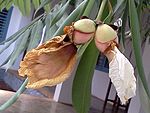– Etymology:
– Generic name after J. Mesue (777–857)
– Specific epithet from Latin, meaning belonging to iron
– Reference to famed and very hard, durable timber
– No personal pronouns used in the content
– Etymology includes Mesue and Latin meaning
– Common Names:
– Ceylon ironwood
– Cobras saffron
– Indian rose chestnut
– Ironwood tree
– Mesua, poached egg tree
– Various common names in different languages
– Habitat:
– Native to Sri Lanka, India, southern Nepal, Burma, Thailand, etc.
– Grows in evergreen forests, especially in river valleys
– Can grow at altitudes up to 1,500m (4,900ft)
– Only ironwood forest in the dry zone with wet zone vegetation
– No personal pronouns used in the content
– Morphology:
– Tree grows up to 13m (43ft) tall
– Dark green leaves 7–15cm (2.8–5.9in) long
– Flowers terminal or axillary, bisexual
– Fruits are reddish, conical hard and ovoid
– Seeds contain lipids, moisture, protein, starch, etc.
– Physical Properties and Composition:
– Major fatty acids in nagkesar oil are oleic acid, linoleic acid, stearic acid, palmitic acid
– Polyphenols and volatiles contribute to odor
– Fatty acid composition and physical properties listed
– No personal pronouns used in the content
– Composition includes fatty acids and physical properties
This article needs additional citations for verification. (April 2019) |
Nagkesar oil is extracted from seeds of the nagkesar tree (Mesua ferrea, Hindi: नागकेसर). It belongs to the Calophyllaceae family. It is an East Indian evergreen tree and is often planted as an ornamental for its fragrant white flowers that yield a perfume. It is the source of hardwood used for railroad ties. It is Sri Lanka's national tree.





